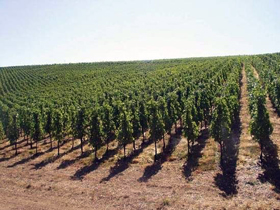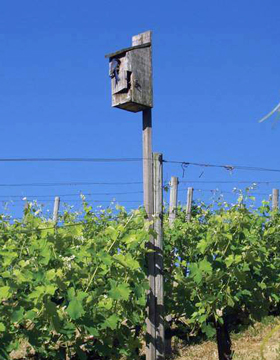A Wine Warrior and His Bug-Killing Bluebirds
Of the all the things that go into making a great wine, none is more important than the fruit. Simply put, you can’t make great wine without great grapes. That’s why it is so important for a grape grower not only to nurture the grapes in the vineyard, but to find ways to protect them from the ravages inflicted by both man and nature.
It takes a warrior.
Fortunately, at Spring Mountain Vineyards in St. Helena, Calif., the vines have Vineyard Manager Ron Rosenbrand as their warrior, protecting the crops from dehydration, mildew, pests and disease.

June is the time of year when the grapes begin to mature. The bloom occurred in late May and clusters have formed as the fruit has begun to set where the flowers were. Each day the grapes are “sizing” that is, they are growing from their present green-pea size until they reach veraison, which is when they begin to soften and start to take on the color and characteristics of their varietal.
“Weather has more influence on farming than anything else that happens in a vineyard,” says Ron, “and while things have been temperate we have not had any significant rain since February.” The dry weather means that steps must be taken to prevent both dehydration and the potential for mildew.
Ron is constantly checking the vines for dehydration using a double verification system. “First, we have c-probes (Capacitance probes) in the soil that measure moisture content in the ground,” he explains. “Next we check the leaves of the plants themselves in a device we call a pressure bomb.” Also known as a Plant Water Status Console, a leaf from the vine is placed in a chamber where it is subjected to increasing air pressure. As moisture is forced out of the petiole (the stalk of the leaf) a measurement is made that indicates the level of “plant moisture stress” in the vine. Using these two pieces of information, Ron can determine how much irrigation is needed in the vineyards.
Right now we are averaging about four gallons of water per week, per plant,” he says. With around 350,000 plants that is a significant amount of water. It may be counterintuitive, but mildew is actually a bigger problem when the temperatures are moderate and the air is dry. “Mildew potential is highest when it is 75- 85 degrees and dry,” says Ron. The fungus, a significant enemy in California vineyards, can stunt the berries’ growth, change the flavor profiles of the grapes and scar the vines.
As Spring Mountain moves towards organic status (they hope to have 60 percent of their vines certified as organic in 2010, following a 3-year process), Ron has worked with the Organic Materials Review Institute (OMRI) to source products that eradicate the fungus from the vine.
The organic initiative has also led to new ways of controlling pests like mealy bugs in the vineyards. “We bring in a small parasitic wasp called Anagyrus,” Ron explains with excitement. “The wasp lays its eggs into the female mealy bug and when the eggs hatch they consume the mealy bug.” Gruesome perhaps, but it is the circle of life at work inside the vines.

Ron is an evangelist for the techniques that are employed at Spring Mountain. “The bio-warfare techniques that we have are as successful as anything that we have ever used to protect the vines,” he says, “and it is much more favorable for the vineyards and the health of our overall environment.” Ron feels that the entire Spring Mountain appellation has gotten on board with the sustainable farm practices. “We are a community up here and there is lots of camaraderie and cooperation.” He sites neighbors Barnett Vineyards and Cain Cellars as neighboring vineyards with whom he discusses and exchanges ideas.
Perhaps the newest bio idea to energize Ron has been the rapid introduction of bluebirds into the Spring Mountain site. “We had about 30 bluebird houses on the property at the beginning of this year,” he explains. “Bluebirds are our best friend when it comes to clearing out the sharpshooters and I was looking for a way to get some more protection from the bugs.”
Blue-green sharpshooters are pests that transmit the dreaded Pierce’s Disease. This bacteria is injected by the sharpshooter directly into the vine and can cause a vine to dehydrate and die within two to three years. Eradicating the bug is a major task and one on the mind of every grower in California wine country.
“I was told that the best way to get more bluebirds was to simply put up bluebird houses,” Ron says. The houses have a small hole in the front that only bluebirds (and occasionally swallows) can fit into; build them and they will come.
“We erected about 100 more bluebird houses around the property and they have flocked to the vineyard. We have increased our bluebird population by at least a third in just the last few months.”
Thanks to the reconnaissance missions of the birds and the watchful eye of a warrior, the grapes are thriving this June at Spring Mountain.
This is the second in a series of articles detailing what goes on in a vineyard on a monthly basis. Our focus is Spring Mountain Vineyard in St. Helena, Calif.
Kelly J. Hayes lives in the soon-to-be designated appellation of Old Snowmass with his wife, Linda, and a black Lab named Vino. He can be reached at malibukj@wineink.com.